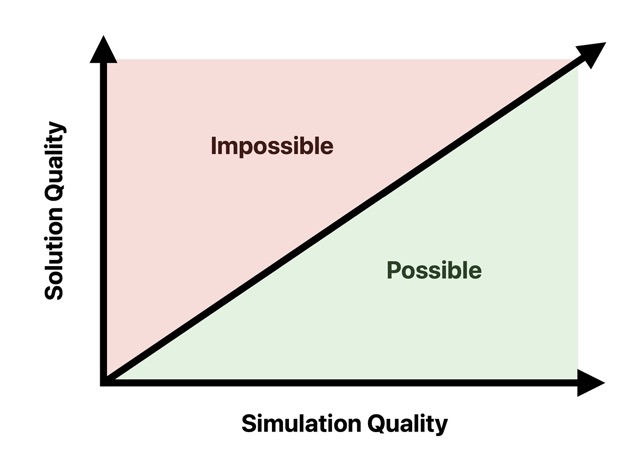Solution Quality vs Simulation Quality
February 19th, 2025
Your ability to simulate a problem almost always affects how well you solve that problem. In many cases the best way to improve a solution is to make simulating the problem easier, quicker, etc. The solution should naturally improve afterwards.
I’d go so far as to say that the quality of a solution is capped by how well the problem can be simulated. Consider the following chart.

All features, projects, or products lie somewhere on the bottom half of this chart. A product development team with X simulation capabilities produces a solution of Y quality. It suggests that sometimes your solution is as good as you can get it without first creating a better simulator. This invisible upper bound is everywhere and I would bet that if you spent a day looking you might find that many solutions are hitting that boundary.
Software people often think about the users or programs happy path. This is the path that you anticipate a user or program staying in through an expected user workflow or program execution.
Discussed far less though is the development happy path. The features that are easy for the people building the product to test, the data they have available to them, the system state they can easily reproduce, and the parts of problem space that are easiest to explore. The part of the product with the highest quality is almost always in the development happy path, and visa versa.
After I thought about this for some time I came across the company antithesis, particularly this blog post and the story of FoundationDB. A couple of quotes from that post about the story of building FoundationDB stuck out to me.
… the part that seemed hardest was how on earth you could test or validate such a thing, and how you could gain confidence in its correctness.
So we did something crazy, which turned out to be the best decision we made in the whole history of the company. Before we even started writing the database, we first wrote a fully-deterministic event-based network simulation that our database could plug into.
This is exactly it. While not all of us work on problems that require incredibly low level simulation with an explodingly large state space, there is a lot to learn from the tactic.
In the case of FoundationDB the value proposition is an ACID compliant distributed database which works under all imaginable failure states distributed systems are subject to. Building a network simulator was crucial to align their development happy path with their value proposition.
I’ll end with a clip of a guy named Bret Victor, giving a talk he called Inventing on Principle. I recommend you watch the entire video when you have the time, but for now I’ll highlight one section. The discussion and demos from 10:33 to 14:35 is exactly what I’m writing about. If you want to be able to solve something well, you need to be able to simulate the problem well. What he shows is an example of this.
There are many problems with mediocore solutions in need of exceptional simulators.